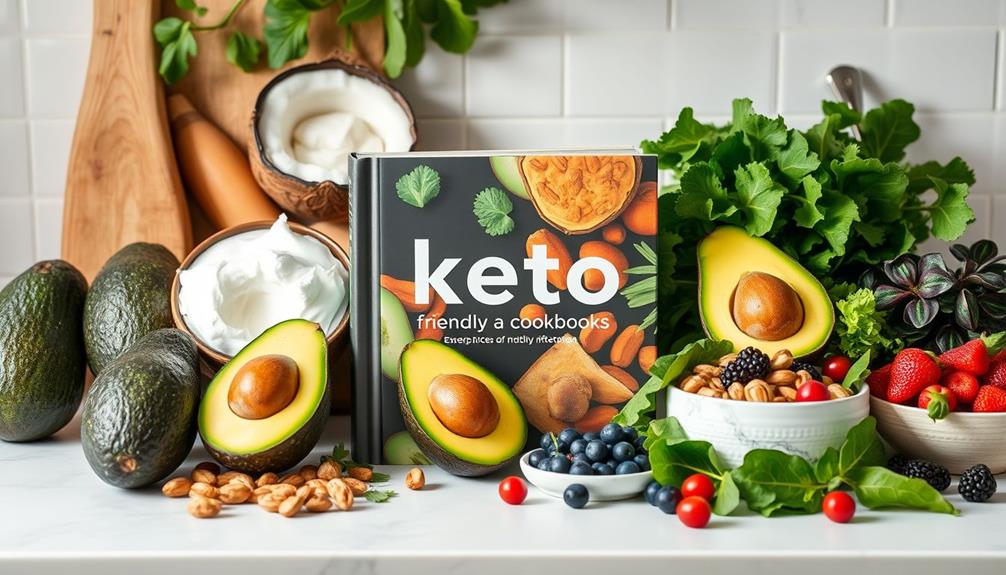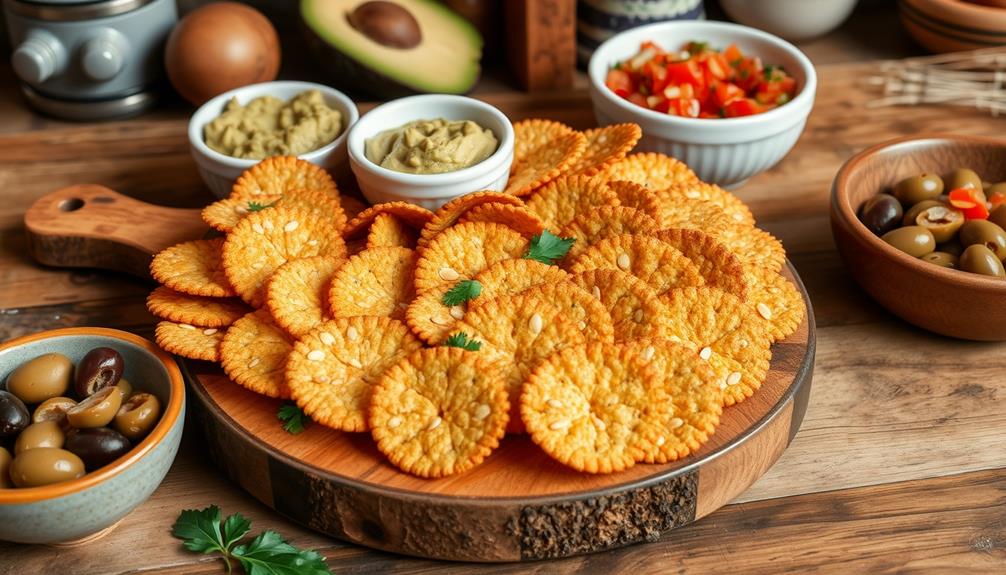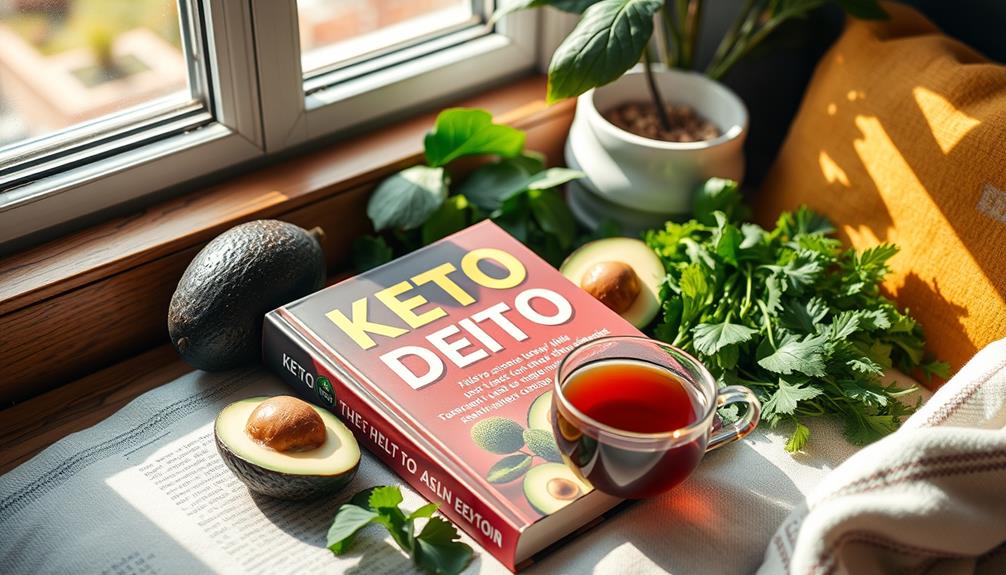To follow the keto diet at home, focus on a high-fat, low-carb meal plan. Aim for 70-75% of your calories from fats, keeping carbs to under 50 grams daily. Stock up on healthy fats like avocados, fatty fish, and nuts, while incorporating low-carb vegetables such as leafy greens. Meal planning and prep are essential to avoid high-carb temptations, so try planning meals in advance. Stay hydrated and monitor your electrolytes to prevent keto flu symptoms. Connecting with online communities can also provide support and inspiration as you navigate your new lifestyle. You're just getting started!
Key Takeaways
- Focus on a high-fat, low-carb diet with 70-75% fats, 20-25% protein, and 5-10% carbohydrates for effective ketosis.
- Incorporate essential high-fat foods like avocados, fatty fish, and nuts while choosing low-carb vegetables such as leafy greens and cruciferous options.
- Plan and prep meals in advance to maintain keto-friendly eating habits and resist high-carb temptations.
- Stay hydrated by drinking 8-10 cups of water daily and monitor electrolytes to prevent keto flu symptoms.
- Join online communities for support, recipe sharing, and motivation to successfully navigate your keto journey.
Understanding the Keto Diet

The ketogenic diet is a popular high-fat, low-carbohydrate eating plan that can transform how your body sources energy. By markedly reducing your carbohydrate intake to about 20-50 grams per day, you can enter ketosis, a metabolic state where your body shifts from burning glucose to burning fats for fuel.
This process produces ketones in the liver, providing an alternative energy source that can enhance weight loss and appetite control. Effective Strategies for Weight Loss emphasize the importance of a balanced approach to dieting.
To successfully follow the keto diet, you'll focus on a high fat diet consisting of 70-75% healthy fats, 20-25% protein, and just 5-10% carbohydrates. Meal ideas should emphasize foods rich in healthy fats, such as avocados, eggs, and fatty fish, while incorporating low-carb vegetables.
It's vital to avoid foods high in sugar, grains, and most fruits, as they can hinder your ability to maintain ketosis.
Understanding the balance of macronutrients and selecting the right foods is fundamental for your success on a low carb diet. By adhering to these principles, you can harness the benefits of the ketogenic diet, turning it into a sustainable lifestyle choice for your health and wellness.
Key Foods for Keto Success

To succeed on the keto diet, you need to focus on essential high-fat foods that keep you in ketosis.
Incorporating low-carb vegetables and smart snack options will help you stay within your carb limits while ensuring you get the nutrients you need.
Understanding how different foods impact your energy levels can be vital, just like how various brewing methods affect caffeine content markedly in coffee coffee brewing methods.
Let's explore the key foods that will support your keto journey.
Essential High-Fat Foods
Essential high-fat foods form the backbone of a successful keto diet, ensuring you meet your macronutrient goals while enjoying delicious meals. Incorporating these foods into your daily routine can help you thrive on keto. Here's a quick guide to some must-have high-fat options:
| Food Type | Example | Fat Content per Serving |
|---|---|---|
| Avocados | 1 medium avocado | 15 grams |
| Fatty Fish | Salmon | 20-30 grams |
| Nuts & Seeds | Macadamia nuts | 21 grams per ounce |
| Dairy Products | Heavy cream | 5 grams per tablespoon |
| Healthy Oils | Olive oil | 14 grams per tablespoon |
Each of these high-fat foods provides healthy fats, essential for maintaining energy levels and satiety. Fatty fish not only boost your fat intake but also deliver protein and important omega-3s. Nuts and seeds are perfect for snacking, while dairy products add flavor and richness to your dishes. Don't forget healthy oils like olive oil and coconut oil for cooking and dressings. Embrace these foods, and you'll be well on your way to keto success!
Low-Carb Vegetable Options
Incorporating low-carb vegetables into your keto diet is a game changer for both flavor and nutrition. These veggies aren't only low in net carbs but also high in essential nutrients, making them perfect for your ketogenic diet.
Leafy greens like spinach, kale, and Swiss chard can easily boost your meals while keeping carb counts low. Additionally, these greens are rich in antioxidants, which can support overall health and wellness antioxidant benefits.
Cruciferous vegetables such as broccoli, cauliflower, and Brussels sprouts are excellent choices, offering fiber and vitamins with only 2-4 grams of net carbs per serving.
Zucchini is a versatile low-carb vegetable; you can spiralize it into noodles or use it in baking, containing just 2 grams of net carbs per 100 grams.
Don't overlook bell peppers—especially green ones. They provide a sweet crunch with about 3 grams of net carbs per 100 grams, making them great to add to salads or stir-fries.
Finally, avocados stand out with their high healthy fat content, offering around 9 grams of carbs (7 grams net) per 100 grams while being rich in potassium and fiber.
Embrace these low-carb vegetable options to enhance your keto success!
Snacks to Include
Maintaining your energy levels and satisfaction on a keto diet often comes down to the right snacks. You'll want to focus on high-fat snacks that keep you full while sticking to low-carb options.
For instance, understanding your budget can help you make informed choices about purchasing high-quality snacks, which is an essential part of your overall financial health budgeting for snacks. Avocados are a fantastic choice, offering about 15 grams of healthy fat per fruit. Nuts and seeds, like almonds and chia seeds, are also excellent; a 1-ounce serving of almonds provides approximately 14 grams of fat with only 6 grams of carbs.
Cheese, especially hard varieties like cheddar or parmesan, is another tasty, low-carb option, containing around 9 grams of fat and less than 1 gram of carbs per serving. Hard-boiled eggs make a nutrient-dense snack too, delivering about 5 grams of fat and 6 grams of protein each.
Don't forget keto-friendly snacks like pork rinds or beef jerky. Pork rinds have zero carbs and about 9 grams of fat per ounce, while beef jerky is high in protein and fat, perfect for on-the-go energy.
Meal Planning Strategies

Meal planning is key to staying on track with your keto diet.
You'll want to focus on essential foods, effective meal prep tips, and tasty snack ideas that keep your meals satisfying and aligned with your goals.
Consider incorporating easy homemade flautas as a delicious and versatile option that can fit into your keto meal plan.
Let's explore how to create a plan that works for you!
Essential Foods to Include
To successfully follow a keto diet at home, focus on including essential high-fat foods that make up a significant portion of your daily caloric intake. Aim for 70-75% of your calories from healthy fats like avocados, nuts, seeds, fatty fish, and oils, which are critical for effective relief from cravings and maintaining energy levels during your diet. These foods are fundamental for achieving and maintaining ketosis.
Additionally, consider incorporating natural remedies that may support your overall health throughout the keto journey.
Incorporate low-carb vegetables such as leafy greens, broccoli, and cauliflower to boost your nutrient intake while keeping your carb count between 20-50 grams per day. These veggies not only provide fiber but also essential vitamins and minerals.
Don't forget quality protein sources. Eggs, poultry, and unprocessed dairy are excellent choices that guarantee you're meeting your protein needs without tipping the scales on your macronutrient intake.
Effective meal planning is key. Use meal planning tools and keto-friendly recipes to prep meals in advance, making it easier to stick to your diet and resist high-carb temptations.
Effective Meal Prep Tips
Effective meal prep is essential for staying on track with your keto diet. Start by planning meals that focus on high-fat, low-carb ingredients, aiming for a macronutrient ratio of 70% fat, 25% protein, and 5% carbs. This will help maintain ketosis effectively.
Incorporating essential oils for oral health can also support your overall well-being while following the diet. Batch cooking is a game changer; prepare your meals in advance to save time and guarantee keto-friendly options are readily available, reducing the temptation to reach for high-carb foods.
Utilize containers for portion control, making it easier to track your macronutrient intake and prevent overeating. Incorporate a variety of keto-friendly recipes like zucchini noodles, cauliflower rice stir-fry, and fat bombs to keep your meals exciting.
Remember to regularly check food labels for hidden carbs, especially in processed foods, as these can sneak into your diet and disrupt your progress.
Lastly, keep a list of keto-approved snack options handy to facilitate quick, on-the-go choices. By organizing your meal prep, you'll empower yourself to stick to your keto diet and enjoy your journey towards better health.
Snack Ideas for Keto
Snacking on a keto diet doesn't have to be boring or complicated. You can enjoy a variety of delicious, low-carbohydrate snacks that will keep you satisfied and help maintain ketosis.
Start with cheese slices, hard-boiled eggs, or olives, which are high in healthy fats and protein, making them perfect snack ideas. Additionally, be cautious of snacks that are high in sugars and unhealthy fats, as ice cream's high sugar content can derail your keto efforts.
Incorporate nuts and seeds, like almonds or sunflower seeds, for a nutrient-dense option that's easy to grab on the go.
Pair crunchy vegetables such as celery, cucumber, or bell peppers with high-fat dips like guacamole or cream cheese for a revitalizing treat.
For those moments when you crave something sweet, whip up fat bombs using coconut oil, nut butter, and unsweetened cocoa powder. These small bites can provide a quick energy boost without the hidden sugars lurking in many pre-packaged snacks.
Always check labels carefully to avoid unexpected ingredients that could disrupt your ketosis.
Managing Macronutrient Intake

Managing macronutrient intake is vital for successfully following the Keto Diet at home. You should aim to keep your daily carb intake between 20-50 grams to guarantee your body enters and maintains ketosis.
In addition to monitoring your macronutrients, diversifying your investment strategies can also be beneficial for long-term financial health, similar to how gold IRAs can protect against market downturns and inflation investment strategies in precious metals.
Focus on a macronutrient distribution of approximately 70-75% fats, 20-25% protein, and 5-10% carbohydrates. This balance optimizes fat burning and energy levels.
Utilizing food tracking apps or journals is essential to monitor macronutrient ratios and portion sizes. This way, you can make adjustments as necessary to meet your dietary goals.
Prioritize high-fat foods like avocados, nuts, seeds, olive oil, and fatty fish while being vigilant to avoid hidden carbs found in processed foods and sugary items.
Regularly assess your overall caloric intake, as successful weight loss on the keto diet hinges on maintaining a calorie deficit while adhering to the specified macronutrient ratios.
Overcoming Common Challenges

When starting the keto diet, you might face several common challenges that can test your commitment. One of the biggest hurdles is the dreaded keto flu, which can bring fatigue and irritability as your body adjusts. To overcome these symptoms, increase your water intake and guarantee you're getting enough sodium, potassium, and magnesium.
Engaging your imagination for solutions can help you navigate these initial roadblocks and visualize your success on the diet.
Meal planning is essential for your success. Keep a well-stocked kitchen with keto-friendly foods so you can avoid high-carb snacks when hunger strikes. By monitoring portion sizes and macronutrient ratios, you can stay within the recommended limits of fewer than 50 grams of carbs per day for effective ketosis.
When cravings for carbohydrates hit, don't despair. You can combat cravings by experimenting with keto-friendly alternatives and recipes that replicate your favorite high-carb dishes. This makes it easier to adhere to the diet without feeling deprived.
Lastly, connecting with support groups or online forums can be incredibly helpful. Sharing experiences and gaining motivation from others facing similar challenges can make your keto journey more manageable and enjoyable.
With the right strategies, you'll be well-equipped to overcome these common obstacles and thrive on your keto diet.
Importance of Hydration and Electrolytes

As you commence your keto journey, understanding the importance of hydration and electrolytes can't be overstated. During ketosis, your body excretes more water and electrolytes, increasing the risk of dehydration. This is why maintaining proper hydration is essential. Aim to drink at least 8-10 cups of water daily.
Sodium is crucial, especially to ward off symptoms of "keto flu." When you cut carbs, your body loses sodium more rapidly, so you'll need to monitor your intake.
Potassium plays an important role too, helping maintain fluid balance and muscle function. Aim for a daily intake of 2,500 to 3,000 mg.
Don't overlook magnesium, which is significant for energy production and can alleviate muscle cramps. Adults should target around 300-400 mg per day.
If you're struggling to meet these needs through food alone, consider using electrolyte supplements to help maintain balance.
Finding Support and Resources

Staying hydrated and maintaining electrolyte balance are just the beginning of your keto journey. To truly thrive, seek out support and resources that can enhance your experience.
Joining online communities and support groups is a great way to connect with others on the same path. These platforms offer motivation, accountability, and shared personal success stories that can inspire you.
Don't forget to tap into expert insights from reputable resources like Cleveland Clinic and Mayo Clinic. They provide valuable guidelines and meal planning strategies to help you achieve proper nutrition on the Keto Diet.
Local or online Keto-specific communities can also be helpful; members often share delicious Keto recipes, tips, and grocery lists to ease your changeover.
To monitor your macronutrient intake and track your progress, consider using health tracking apps. These tools can alert you to any symptoms and keep you on course with your dietary goals.
Frequently Asked Questions
How Can I Start Keto Diet on My Own?
To start your keto diet, calculate your macronutrient needs, focus on high-fat foods, plan meals, track your intake, and prepare for initial side effects. Staying hydrated and balanced will ease your changeover into ketosis.
What Are the 9 Rules of Keto?
You might think keto's too restrictive, but it's all about balance. Follow these nine rules: limit carbs, emphasize healthy fats, moderate protein, stay hydrated, balance electrolytes, plan meals, track intake, choose whole foods, and adjust as needed.
What Is the Simplest Way to Do Keto?
The simplest way to do keto is to limit carbs to 20-50 grams daily, boost healthy fats, focus on whole foods, and prep meals in advance. Staying hydrated and tracking macros helps you succeed.
What Is the Trick to Keto Diet?
Think of the keto diet like a tightrope walk; you've gotta balance your carb intake carefully. The trick's limiting carbs to 20-50 grams daily, ensuring your body burns fat for energy instead.
Conclusion
To sum up, following the keto diet at home can be both rewarding and manageable with the right approach. By understanding the essentials, planning meals, and staying mindful of your macros, you'll set yourself up for success. Remember, it's not just about cutting carbs; it's about fueling your body effectively. So, are you ready to embrace this lifestyle and transform your health from the comfort of your own kitchen? Let's get started! When it comes to the keto diet basics, it’s important to focus on consuming high-fat, moderate-protein, and low-carb foods. This means incorporating sources of healthy fats like avocados, nuts, and olive oil into your meals, while also being mindful of your protein intake. Additionally, it’s essential to limit your consumption of foods high in carbohydrates, such as bread, pasta, and sugary snacks. By following these principles and staying committed to the keto lifestyle, you’ll be well on your way to achieving your health and wellness goals.









